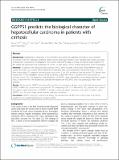| dc.contributor.author | Yu, De-cai | en_US |
| dc.contributor.author | Liu, Jia | en_US |
| dc.contributor.author | Chen, Jun | en_US |
| dc.contributor.author | Shao, Jiao-jiao | en_US |
| dc.contributor.author | Shen, Xiao | en_US |
| dc.contributor.author | Xia, Hong-guang | en_US |
| dc.contributor.author | Li, Chao-jun | en_US |
| dc.contributor.author | Xue, Bin | en_US |
| dc.contributor.author | Ding, Yi-tao | en_US |
| dc.date.accessioned | 2014-07-07T18:14:38Z | |
| dc.date.issued | 2014 | en_US |
| dc.identifier.citation | Yu, De-cai, Jia Liu, Jun Chen, Jiao-jiao Shao, Xiao Shen, Hong-guang Xia, Chao-jun Li, Bin Xue, and Yi-tao Ding. 2014. “GGPPS1 predicts the biological character of hepatocellular carcinoma in patients with cirrhosis.” BMC Cancer 14 (1): 248. doi:10.1186/1471-2407-14-248. http://dx.doi.org/10.1186/1471-2407-14-248. | en |
| dc.identifier.issn | 1471-2407 | en |
| dc.identifier.uri | http://nrs.harvard.edu/urn-3:HUL.InstRepos:12406973 | |
| dc.description.abstract | Background: Hepatocellular carcinoma (HCC) has been associated with diabetes and obesity, but a possible connection with the metabolic syndrome (MetS) and its potential interaction with hepatitis and cirrhosis are open to discussion. Our previous investigations have shown that GGPPS1 plays a critical role during hyperinsulinism. In this report, the expression and distribution of GGPPS1 in liver cancer, and its clinical significance were investigated. Methods: 70 patients with hepatocellular carcinoma (HCC) were included in this study. Three different types of tissues from each HCC patient were assembled immediately after surgical resection: tumor-free tissue >5 cm far from tumor edge (TF), adjacent nonmalignant tissue within 2 cm (AT), and tissue from the tumor (TT). Normal liver tissues from 10 liver transplant donors served as healthy control (HC) while 10 patients with liver cirrhosis as cirrhosis control (CC). The expression and distribution of GGPPS1 were detected by immunohistochemistry, western blots, or real-time PCR. The relationship between the expression of GGPPS1 and clinic pathologic index were analyzed. Results: We found that GGPPS1 was intensified mainly in the cytoplasm of liver tumor cells. Both the expression of GGPPS1 mRNA and protein were upregulated in TT comparing to AT or TF. Meanwhile, HCC patients with cirrhosis had relative higher expression of GGPPS1. In addition, many pathologic characters show close correlation with GGPPS1, such as tumor stage, vessel invasion, and early recurrence. Conclusion: GGPPS1 may play a critical role during the development of HCC from cirrhosis and is of clinical significance for predicting biological character of HCC. | en |
| dc.language.iso | en_US | en |
| dc.publisher | BioMed Central | en |
| dc.relation.isversionof | doi:10.1186/1471-2407-14-248 | en |
| dc.relation.hasversion | http://www.ncbi.nlm.nih.gov/pmc/articles/PMC4028285/pdf/ | en |
| dash.license | LAA | en_US |
| dc.title | GGPPS1 predicts the biological character of hepatocellular carcinoma in patients with cirrhosis | en |
| dc.type | Journal Article | en_US |
| dc.description.version | Version of Record | en |
| dc.relation.journal | BMC Cancer | en |
| dash.depositing.author | Xia, Hong-guang | en_US |
| dc.date.available | 2014-07-07T18:14:38Z | |
| dc.identifier.doi | 10.1186/1471-2407-14-248 | * |
| dash.contributor.affiliated | Xia, Hong-guang | |


